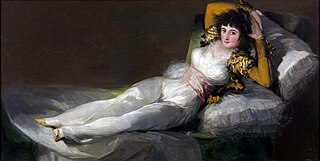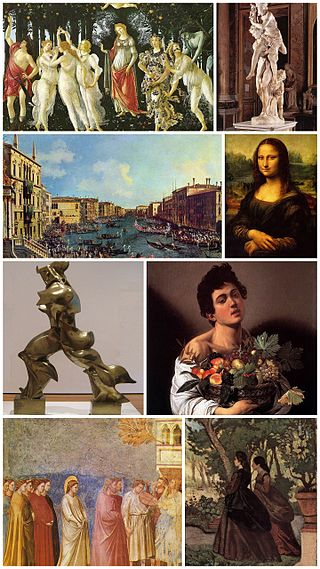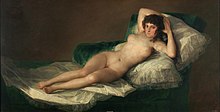A cultural movement is a change in the way a number of different disciplines approach their work. This embodies all art forms, the sciences, and philosophies. Historically, different nations or regions of the world have gone through their own independent sequence of movements in culture, but as world communications have accelerated this geographical distinction has become less distinct. When cultural movements go through revolutions from one to the next, genres tend to get attacked and mixed up, and often new genres are generated and old ones fade.: These changes are often reactions against the prior cultural form, which typically has grown stale and repetitive. An obsession emerges among the mainstream with the new movement, and the old one falls into neglect – sometimes it dies out entirely, but often it chugs along favored in a few disciplines and occasionally making reappearances.

Romanticism is an artistic and intellectual movement that originated in Europe towards the end of the 18th century. In most parts of Europe, it was at its peak from approximately 1800 to 1850. Romanticism was characterized by its emphasis on emotion and individualism as well as glorification of the past and nature, preferring the medieval to the classical. Romanticism was partly a reaction to the Industrial Revolution, and the prevailing ideology of the Age of Enlightenment, especially the scientific rationalization of Nature. It was embodied most strongly in the visual arts, music, and literature; it also had a major impact on historiography, education, chess, social sciences, and the natural sciences. It had a significant and complex effect on politics: Romantic thinking influenced conservatism, liberalism, radicalism, and nationalism.

Neoclassicism was a Western cultural movement in the decorative and visual arts, literature, theatre, music, and architecture that drew inspiration from the art and culture of classical antiquity. Neoclassicism was born in Rome largely thanks to the writings of Johann Joachim Winckelmann, at the time of the rediscovery of Pompeii and Herculaneum, but its popularity spread across Europe as a generation of European art students finished their Grand Tour and returned from Italy to their home countries with newly rediscovered Greco-Roman ideals. The main Neoclassical movement coincided with the 18th-century Age of Enlightenment, and continued into the early 19th century, laterally competing with Romanticism. In architecture, the style continued throughout the 19th, 20th and up to the 21st century.

The term neo-romanticism is used to cover a variety of movements in philosophy, literature, music, painting, and architecture, as well as social movements, that exist after and incorporate elements from the era of Romanticism.
An art movement is a tendency or style in art with a specific common philosophy or goal, followed by a group of artists during a specific period of time, or, at least, with the heyday of the movement defined within a number of years. Art movements were especially important in modern art, when each consecutive movement was considered a new avant-garde movement. Western art had been, from the Renaissance up to the middle of the 19th century, underpinned by the logic of perspective and an attempt to reproduce an illusion of visible reality. By the end of the 19th century many artists felt a need to create a new style which would encompass the fundamental changes taking place in technology, science and philosophy.

The art of Europe, also known as Western art, encompasses the history of visual art in Europe. European prehistoric art started as mobile Upper Paleolithic rock and cave painting and petroglyph art and was characteristic of the period between the Paleolithic and the Iron Age. Written histories of European art often begin with the Aegean civilizations, dating from the 3rd millennium BC. However a consistent pattern of artistic development within Europe becomes clear only with Ancient Greek art, which was adopted and transformed by Rome and carried; with the Roman Empire, across much of Europe, North Africa and Western Asia.

Since ancient times, Greeks, Etruscans and Celts have inhabited the south, centre and north of the Italian peninsula respectively. The very numerous rock drawings in Valcamonica are as old as 8,000 BC, and there are rich remains of Etruscan art from thousands of tombs, as well as rich remains from the Greek colonies at Paestum, Agrigento and elsewhere. Ancient Rome finally emerged as the dominant Italian and European power. The Roman remains in Italy are of extraordinary richness, from the grand Imperial monuments of Rome itself to the survival of exceptionally preserved ordinary buildings in Pompeii and neighbouring sites. Following the fall of the Roman Empire, in the Middle Ages Italy, especially the north, remained an important centre, not only of the Carolingian art and Ottonian art of the Holy Roman Emperors, but for the Byzantine art of Ravenna and other sites.

Romantic poetry is the poetry of the Romantic era, an artistic, literary, musical and intellectual movement that originated in Europe towards the end of the 18th century. It involved a reaction against prevailing Enlightenment ideas of the 18th century, and lasted approximately from 1800 to 1850. Romantic poets rebelled against the style of poetry from the eighteenth century which was based around epics, odes, satires, elegies, epistles and songs.

Karl Pavlovich Bryullov, original name Charles Bruleau, also transliterated Briullov and Briuloff, and referred to by his friends as "Karl the Great", was a Russian painter. He is regarded as a key figure in transition from the Russian neoclassicism to romanticism.
Painting – artwork in which paint or other medium has been applied to a surface, and in which area and composition are two primary considerations.

Dark Romanticism is a literary sub-genre of Romanticism, reflecting popular fascination with the irrational, the demonic and the grotesque. Often conflated with Gothic fiction, it has shadowed the euphoric Romantic movement ever since its 18th-century beginnings. Edgar Allan Poe is often celebrated as one of the supreme exponents of the tradition. Dark Romanticism focuses on human fallibility, self-destruction, judgement, punishment, as well as the psychological effects of guilt and sin.

La maja vestida is an oil painting on canvas created between 1800 and 1807 by the Spanish Romantic painter and printmaker Francisco Goya. It is a clothed version of the earlier La maja desnuda, which was created between 1795 and 1800. The identity of the model and that of the commissioner have not been confirmed. However, art historians and scholars have suggested she is María Cayetana de Silva or Godoy's mistress Pepita Tudó. The Clothed Maja was created during the peak of Romanticism.

Modern Greek art is art from the period between the emergence of the new independent Greek state and the 20th century. As Mainland Greece was under Ottoman rule for all four centuries, it was not a part of the Renaissance and artistic movements that followed in Western Europe. However, Greek islands such as Crete, and the Ionian islands in particular were for large periods under Venetian or other European powers' rule and thus were able to better assimilate the radical artistic changes that were occurring in Europe during the 14th-18th century.

The nineteenth century marks the period beginning January 1, 1801 and ends December 31, 1900.

Classical Realism is an artistic movement in the late-20th and early 21st century in which drawing and painting place a high value upon skill and beauty, combining elements of 19th-century neoclassicism and realism.
Louis Candide Boulanger was a French Romantic painter, pastellist, lithographer and a poet, known for his religious and allegorical subjects, portraits, genre scenes.

Portrait of Madame Récamier is an 1800 portrait of the Parisian socialite Juliette Récamier by Jacques-Louis David showing her in the height of Neoclassical fashion, reclining on a Directoire style sofa in a simple Empire line dress with almost bare arms, and short hair "à la Titus." The work is unfinished.

From the second half of the 18th century through the 19th century, Italy went through a great deal of socio-economic changes, several foreign invasions and the turbulent Risorgimento, which resulted in the Italian unification in 1861. Thus, Italian art went through a series of minor and major changes in style.

Realism was an artistic movement that emerged in France in the 1840s, around the 1848 Revolution. Realists rejected Romanticism, which had dominated French literature and art since the early 19th century. Realism revolted against the exotic subject matter and the exaggerated emotionalism and drama of the Romantic movement. Instead, it sought to portray real and typical contemporary people and situations with truth and accuracy, and not avoiding unpleasant or sordid aspects of life. The movement aimed to focus on unidealized subjects and events that were previously rejected in art work. Realist works depicted people of all classes in situations that arise in ordinary life, and often reflected the changes brought by the Industrial and Commercial Revolutions. Realism was primarily concerned with how things appeared to the eye, rather than containing ideal representations of the world. The popularity of such "realistic" works grew with the introduction of photography—a new visual source that created a desire for people to produce representations which look objectively real.

Brazilian Romantic painting was the main expression of the plastic arts in Brazil in the second half of the 19th century. This pictorial production was part of the local evolution of the Romantic movement and approximately coincided with the period of the Second Reign, but its characteristics were unique, differing in several points in relation to the original version of European Romanticism and likewise cannot be considered an exact parallel to the manifestation of Romanticism in Brazilian literature of the same period. It had a palatial and restrained aspect, brought a strong neoclassical influence and soon blended with Realism, Symbolism and other schools, in an eclectic synthesis that prevailed until the early years of the 20th century.

















